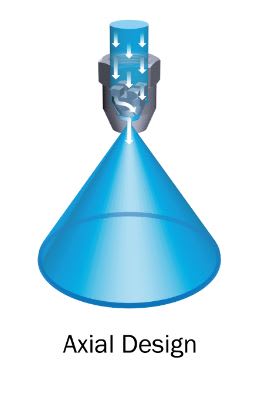The nozzle in your picture atomizes liquid by creating a swirling flow prior to the exit orifice. The swirl causes the fluid to form a thin film on the exit cone that atomizes as it leaves contact with the nozzle. The spray pattern is a hollow cone. A similar effect can be accomplished by spinning a cone-shaped cup at high speed to atomize fluid that gets flung-out from the lip of the cup.
Spray nozzles that have a tiny orifice with no pre-swirling of the fluid will produce a solid cone spray pattern which relies on fluid turbulence to atomize the fluid exiting the nozzle.
There are a multitude of spray nozzle designs, which operate on differing principles for differing spray patterns and fluid properties, such as particulates and clog prevention.


